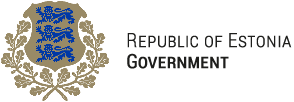The Republic of Estonia gained its independence from the Russian Empire on 24 February 1918 and established diplomatic relations with many countries via membership of the League of Nations. The forcible incorporation of Estonia into the Soviet Union in 1940 was not generally recognised by the international community and the Estonian diplomatic service continued to operate in some countries. Following the restoration of independence from the Soviet Union, Russia was one of the first nations to re-recognize Estonia's independence. Estonia's immediate priority after regaining its independence was the withdrawal of Russian forces from Estonian territory. In August 1994, this was completed. However, relations with Moscow have remained strained primarily because Russia decided not to ratify the border treaty it had signed with Estonia in 1999.

The national flag of Estonia is a tricolour featuring three equal horizontal bands of blue at the top, black in the centre, and white at the bottom. The flag is called sinimustvalge in Estonian.

The Order of the Estonian Red Cross was instituted in 1920 by the Estonian Red Cross Society. The Order of the Estonian Red Cross is bestowed in order to give recognition for humanitarian services rendered in the interests of the Estonian people and for the saving of life.
The State Elder, sometimes also translated as Head of State, was the official title of the Estonian head of state from 1920 to 1937. He combined some of the functions held by a president and prime minister in most other democracies.
Riigihoidja was the name of the office of the head of state and head of the caretaker government of Estonia from 3 September 1937 to 24 April 1938. The first person to hold this position was Konstantin Päts, five time former State Elder. His eventual successor ex officio was Johan Laidoner, then Commander-in-Chief.

The Government of the Republic of Estonia is the cabinet of Estonia. Under the Constitution, it exercises executive power pursuant to the Constitution and laws of Estonia.

Raasiku Parish in Harju County is located in the south-eastern direction from the city of Tallinn. The main road leading through the parish is Jüri - Aruküla - Raasiku - Jägala road. The Tallinn - Tapa Railway goes through the northern border of the parish.
The Constitution of Estonia is the fundamental law of the Republic of Estonia and establishes the state order as that of a democratic republic where the supreme power is vested in its citizens. The first Constitution was adopted by the freely elected Estonian Constituent Assembly on 15 June 1920 and came into force on 21 December 1920. Heavily amended on 24 January 1934, following a referendum in 1933, it was in force until the second Constitution was enacted on 1 January 1938. It remained in force, de facto, until 16 June 1940, when the Soviet Union occupied Estonia and, de jure, until 28 June 1992, when the third and current Constitution of the Republic of Estonia was adopted by referendum.
Elektrooniline Riigi Teataja is the web-based outlet for publication of laws and official announcements of the Republic of Estonia. It is modelled after the older paper-based publication, Riigi Teataja. Under Estonian law, Elektrooniline Riigi Teataja is since 1 June 2002 considered the authoritative reference source for laws of Estonia. Just like Riigi Teataja, eRT is published by Riigikantselei.

Riigi Teataja is a public journal of the Republic of Estonia. The first issue was published on 27 November 1918.

The Police and Border Guard Board is a unified national governmental agency within the Estonian Ministry of Interior and is responsible for law enforcement and internal security in the Republic of Estonia.
Voika is a village in Nõo Parish, Tartu County in eastern Estonia.

Varesrahu is an island belonging to the country of Estonia.

Riho Terras is an Estonian politician and a former military officer who is serving as a member of the European Parliament since 1 February 2020. He was the Commander of the Estonian Defence Forces from 2011 to 2018. He was promoted to general in 2017.
The Minister of Public Administration of Estonia was a minister at the Ministry of Finance in the Estonian Government.
Estonian Restoration of Independence, legally defined as the Restoration of the Republic of Estonia, was proclaimed on 20 August 1991. On that day at 23:02 local time, the Supreme Council of the Republic of Estonia, in agreement with the Estonian Committee, declared the illegal Soviet occupation and annexation of the country terminated, and proclaimed the full restoration of the independence of Estonia.
Erumägi Landscape Conservation Area is a nature park in Tartu County, Estonia.
The Mahtra Peasant Museum is located in Rapla Parish in Rapla County, Estonia. It is a national institution of the Estonian Ministry of Culture and a national museum.









